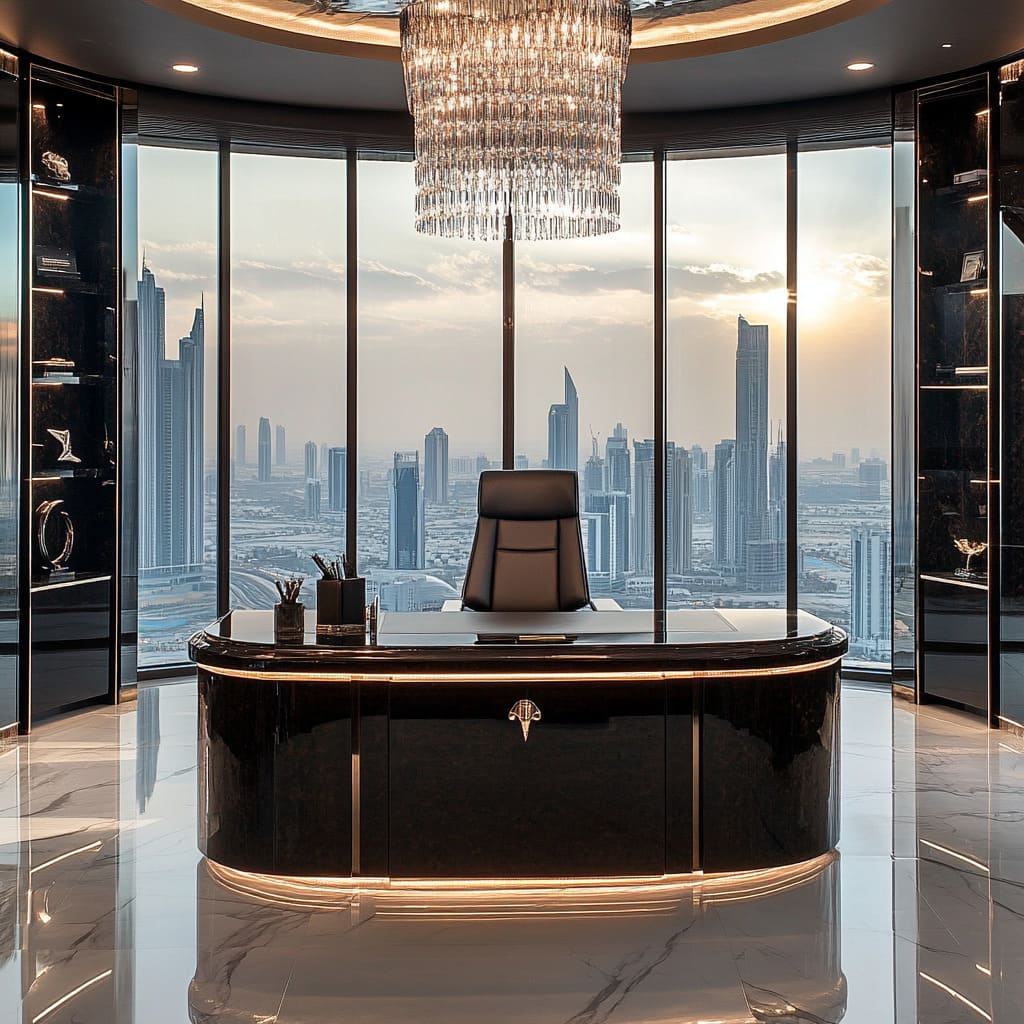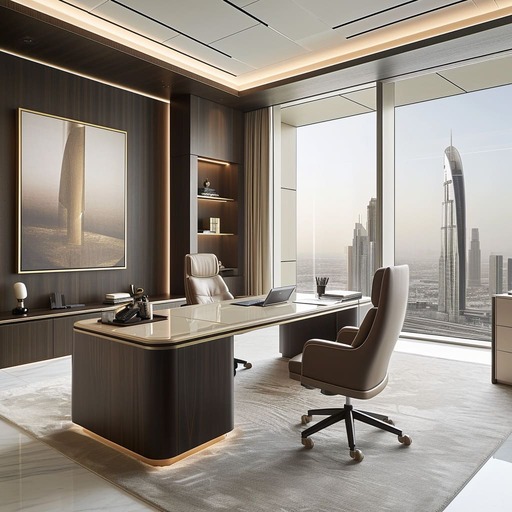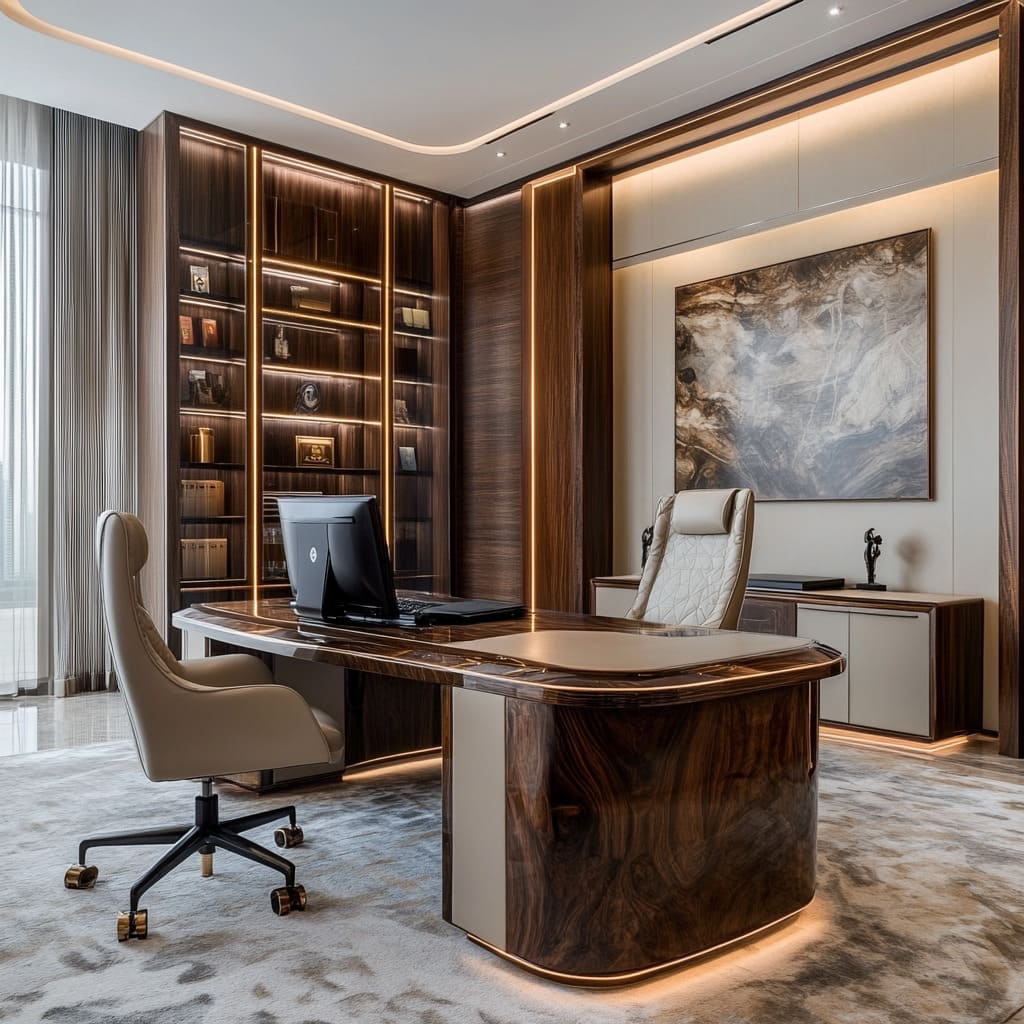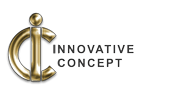Dubai is renowned for its luxury, innovation, and architectural splendor, making it a fitting backdrop for the design of high-end CEO offices. These spaces are not merely functional; they are meticulously crafted environments that reflect both the professional stature and personal taste of their occupants. The design of a CEO office in Dubai combines cutting-edge technology, opulent materials, and strategic layout planning to create a workspace that is both impressive and conducive to productivity. This article delves into the essential elements that define luxury office design in Dubai, exploring how each aspect contributes to the creation of an exceptional working environment.

1. Location and Setting
Importance of Location
The location of a CEO office in Dubai significantly influences its design and overall ambiance. Dubai’s skyline is dotted with iconic skyscrapers, many of which house the offices of some of the world’s most influential business leaders. These buildings, often situated in the heart of the city’s financial districts, offer unparalleled views that become an integral part of the office’s design.
Choosing a high-rise location allows for expansive, unobstructed views of landmarks like the Burj Khalifa or the Dubai Marina, which are not just scenic backdrops but statements of the city’s vibrancy and growth. These views are more than decorative; they enhance the psychological well-being of the office’s occupants by providing a connection to the outside world and a sense of openness. The integration of such views into the office design is a deliberate choice, emphasizing the importance of location in crafting a space that feels prestigious and forward-thinking.
Maximizing Natural Light and Views
The strategic use of floor-to-ceiling windows in these offices is crucial for maximizing natural light and the surrounding views. In Dubai, where sunshine is abundant, the ability to harness this natural light is essential in creating a bright and energizing workspace. The design often includes expansive glass facades that allow light to flood the room, reducing the need for artificial lighting during the day and creating an environment that feels alive and dynamic.
These windows do more than illuminate; they frame the cityscape, turning the surrounding urban landscape into a living piece of art that changes throughout the day. Whether it’s the golden glow of dawn, the bright midday sun, or the shimmering lights of the city at night, the views contribute significantly to the office’s atmosphere, making it a space that is as inspiring as it is functional.
2. Layout and Spatial Organization
Centralized Desk Placement
In a luxury CEO office, the desk is often the focal point around which the entire layout is organized. The placement of the desk is critical, not just for practical reasons, but as a reflection of authority and control. Typically, the desk is positioned facing the windows, ensuring that the CEO has a commanding view while working. This placement is strategic, allowing the occupant to engage with the city’s energy and maintain a connection with the outside world, even during the busiest workdays.
The desk itself is more than a piece of furniture; it is a statement of style and power. Crafted from materials like high-gloss wood, often accented with metals such as gold or chrome, the desk serves as a centerpiece that draws the eye and sets the tone for the rest of the office. The layout around the desk is designed to be both functional and aesthetically pleasing, with ample space for movement and easy access to other parts of the office, such as meeting areas or private spaces.
Flow and Accessibility
The flow of the office is meticulously planned to ensure that it supports the CEO’s work style while maintaining a sense of order and openness. The design often incorporates an open layout that allows for seamless movement between different areas of the office. This openness is not just about physical space; it also encourages a mental state conducive to creativity and clear thinking.
Accessibility is also a key consideration. The office is typically organized in such a way that all essential areas, including the desk, seating areas for guests, storage, and meeting spaces, are within easy reach. This thoughtful planning ensures that the CEO can move from task to task without unnecessary interruptions, making the workspace as efficient as it is luxurious.
3. Furniture and Material Selection
Desk and Seating Design
The furniture in a CEO office is chosen not only for its functionality but also for its ability to convey a sense of prestige and comfort. The desk, often the room’s centerpiece, is usually made from high-quality materials such as lacquered wood, metal, and glass. These materials are selected for their durability and their ability to maintain a sleek, polished appearance over time.
The seating in the office is equally important. The CEO’s chair is typically an executive model that balances ergonomic support with luxurious comfort. Upholstered in premium leather, often in neutral tones like black, taupe, or deep brown, these chairs provide the necessary support for long working hours while maintaining a refined aesthetic. The guest chairs, though slightly less imposing, are designed with the same attention to detail, ensuring that visitors also experience the office’s luxury and comfort.
Choice of Materials
The materials used in the design of a CEO office are chosen for their ability to reflect luxury and sophistication. High-gloss wood, marble, and premium leather are common choices, each bringing a different texture and visual appeal to the space. The combination of these materials creates a contrast that is both visually striking and harmonious.
Marble floors or wall accents, for example, add a sense of timeless elegance, while high-gloss wood provides warmth and depth. The use of metallic accents, such as gold or chrome, adds a touch of opulence, elevating the overall design without overwhelming it. These materials are not just about aesthetics; they are also about creating an environment that feels substantial and enduring, much like the business itself.
Custom-Built Furniture
Custom-built furniture is a hallmark of luxury office design, offering both functionality and a bespoke aesthetic. Shelving units, storage cabinets, and display cases are often custom-designed to fit the specific dimensions of the office, ensuring that every piece feels integrated into the overall design.
These custom elements are usually crafted from the same high-end materials as the other furniture in the room, creating a cohesive look. They provide practical storage solutions while also offering opportunities to display personal items, awards, and decor that reflect the CEO’s personality and achievements. This customization ensures that every element of the office is tailored to the specific needs and tastes of the occupant, making the space truly unique.
4. Lighting Design
Primary and Ambient Lighting
Lighting in a luxury CEO office goes beyond mere functionality; it is an essential part of the overall design that influences the mood and usability of the space. The primary source of light often comes from recessed LED fixtures in the ceiling, strategically placed to provide even illumination across the room. These lights are chosen for their ability to distribute light uniformly, reducing shadows and creating a bright, welcoming environment.
In addition to general lighting, ambient lighting is carefully considered to enhance the atmosphere of the office. This may include cove lighting around the perimeter of the ceiling, which provides a soft, indirect glow that adds warmth and depth to the room. The combination of these lighting types ensures that the office is well-lit at all times, whether during the day or in the evening, creating a versatile space that can adapt to different needs.
Accent Lighting
Accent lighting is used to highlight specific features within the office, such as artwork, architectural details, or key pieces of furniture. This type of lighting is often integrated into shelving units or around display areas, using LED strips or spotlights to draw attention to these elements without overwhelming the space.

The use of accent lighting adds a layer of sophistication to the office, emphasizing the care and attention to detail that has gone into the design. It also allows for greater flexibility in how the space is used, with the ability to create different moods depending on the occasion or time of day.
Mood and Functionality
The lighting design in a CEO office is carefully balanced to meet both functional needs and aesthetic goals. While the primary focus is on ensuring that the space is well-lit and conducive to work, there is also an emphasis on creating a comfortable and inviting atmosphere. The use of warm lighting tones, for example, can soften the room’s overall feel, making it more welcoming and less sterile.
At the same time, the lighting must be functional, providing adequate illumination for tasks such as reading, writing, and using technology. This dual focus on mood and functionality is what sets luxury office lighting apart, ensuring that the space is both practical and pleasing to the senses.
5. Color Palette and Finishes
Neutral and Rich Tones
The color palette in a luxury CEO office is carefully chosen to create a sense of calm and focus. Neutral tones such as taupe, cream, and gray are often used as the base colors, providing a soothing backdrop that allows other design elements to stand out. These colors are chosen for their versatility and their ability to create a sophisticated, understated elegance.
In addition to these neutral tones, richer colors are often introduced through materials like dark wood or metal accents. These deeper tones add contrast and depth to the space, creating a dynamic visual experience that is both engaging and relaxing. The careful balance of neutral and rich tones ensures that the office feels luxurious without being overwhelming.
Texture and Contrast
Texture plays a crucial role in the design of a CEO office, adding layers of interest and complexity to the space. The use of contrasting finishes, such as matte and gloss, creates a tactile experience that enhances the overall design. For example, a high-gloss desk might be paired with a matte leather chair, or a marble floor might be complemented by a soft, plush rug.
These contrasts are not just about visual appeal; they also contribute to the overall feel of the office. The combination of different textures adds warmth and depth, making the space feel more inviting and comfortable. This attention to texture and contrast is a key element of luxury design, ensuring that the office is as pleasing to the touch as it is to the eye.
Wall Treatments and Ceiling Design
The walls and ceiling of a luxury CEO office are more than just structural elements; they are integral parts of the design. Wall treatments, such as wood paneling or textured wallpaper, add visual interest and help define the space. These treatments are often chosen for their ability to complement the overall color palette while adding a layer of sophistication to the room.

The ceiling design is also an important consideration, often featuring recessed elements or metallic finishes that enhance the room’s luxurious feel. A ceiling with a recessed design might include cove lighting that adds depth and dimension, while a metallic finish can create a warm, reflective surface that catches the light and adds a touch of glamour. These elements are carefully chosen to ensure that every aspect of the office, from floor to ceiling, contributes to its overall aesthetic.
6. Decor and Personalization
Artwork and Statement Pieces
The decor in a CEO office is carefully curated to reflect the personality and achievements of its occupant. Large pieces of artwork, such as abstract paintings or sculptures, are often used as focal points within the space. These pieces are chosen for their ability to make a bold statement, adding color, texture, and visual interest to the room.
In addition to artwork, other statement pieces, such as custom-made furniture or unique decor items, are used to personalize the space. These elements add a touch of individuality, making the office feel like a reflection of the CEO’s personal style and taste. The careful selection and placement of these items ensure that the office feels both luxurious and lived-in, creating a space that is both functional and expressive.
Use of Greenery
While the design of a luxury office is often sleek and modern, the use of greenery can add a touch of nature and softness to the space. Plants are chosen for their ability to thrive indoors and are often placed near windows or in corners where they can be both decorative and functional. The presence of greenery not only adds color and life to the office but also contributes to a healthier, more pleasant working environment.
The choice of plants is often influenced by the overall design of the office. For example, a minimalist office might feature a single, sculptural plant, while a more traditional space might include a variety of plants in different sizes and styles. This use of greenery adds a natural element to the office, balancing the sleek, modern design with a touch of warmth and vitality.
Balancing Professionalism with Personal Touches
While the primary focus of a CEO office is on professionalism, there is also room for personal touches that make the space feel more inviting and comfortable. These might include personal items, such as family photos, awards, or memorabilia, that reflect the CEO’s life and achievements. These items are typically displayed in a way that adds to the decor rather than detracting from it, ensuring that the office remains polished and professional.
The balance between professionalism and personalization is key to creating a space that feels both luxurious and functional. By incorporating personal elements into the design, the office becomes a reflection of the CEO’s personality and style, making it a space where they can work effectively and feel at home.
7. Technology Integration
Seamless Technology
In a luxury CEO office, technology is integrated seamlessly into the design to ensure that it enhances the functionality of the space without disrupting its aesthetic. This might include features such as built-in charging stations, cable management systems, and advanced audio-visual equipment. These elements are carefully designed to be unobtrusive, allowing the technology to be used efficiently without cluttering the workspace.
The integration of technology extends to the lighting and environmental controls, which are often automated for convenience. This allows the CEO to adjust the lighting, temperature, and window shades with the touch of a button, ensuring that the office remains comfortable and functional at all times.
Advanced Office Systems
Beyond the basic technology, luxury CEO offices often feature advanced systems that enhance communication and productivity. This might include state-of-the-art video conferencing equipment, high-quality sound systems, and secure data storage solutions. These systems are chosen for their reliability and performance, ensuring that the CEO has everything they need to work effectively.
The design of these systems is also important, with a focus on ensuring that they are easy to use and fit seamlessly into the overall design of the office. This might involve custom-designed cabinetry to house equipment, or the use of wireless technology to reduce the need for visible cables. The goal is to create a workspace that is as technologically advanced as it is aesthetically pleasing.
8. Overall Ambiance and Experience
Creating a Luxurious Yet Functional Environment
The overall ambiance of a luxury CEO office is carefully crafted to create a space that feels both luxurious and functional. Every element, from the choice of materials to the placement of furniture, is designed to create an environment that is both inspiring and conducive to productivity. The use of high-end materials, sophisticated design elements, and carefully chosen decor ensures that the office feels luxurious without being ostentatious.
The functionality of the space is also a key consideration, with the layout and design ensuring that the office supports the CEO’s work style and needs. This might include features such as ample storage, easy access to technology, and a comfortable seating area for meetings or informal discussions. The goal is to create a space that feels both elegant and efficient, allowing the CEO to work effectively while enjoying the luxury of their surroundings.
Reflecting Authority and Sophistication
A luxury CEO office is more than just a place to work; it is a reflection of the CEO’s authority and sophistication. The design of the office is carefully crafted to convey a sense of power and prestige, with elements such as the placement of the desk, the choice of materials, and the use of statement pieces all contributing to this image.
The use of high-end materials, such as marble, leather, and wood, adds to the sense of luxury, while the careful selection of furniture and decor ensures that the office feels both modern and timeless. The overall design is intended to create an environment that reflects the CEO’s status and success, making it a space that commands respect and admiration.
Balancing Aesthetics with Practicality
While the focus of a luxury CEO office is often on aesthetics, practicality is also a key consideration. The design of the office must support the CEO’s work style and needs, ensuring that the space is not just beautiful but also functional. This might include features such as ample storage, easy access to technology, and a comfortable seating area for meetings or informal discussions.
The balance between aesthetics and practicality is what sets luxury office design apart, ensuring that the space is both pleasing to the eye and conducive to productivity. By carefully considering both form and function, the design creates a space that is as efficient as it is elegant, making it a place where the CEO can work effectively and enjoy the luxury of their surroundings.
Conclusion
Dubai’s luxury CEO offices are a testament to the city’s reputation for innovation, elegance, and sophistication. These spaces are carefully designed to reflect the status and personality of their occupants, combining high-end materials, advanced technology, and thoughtful design elements to create environments that are both inspiring and functional. As we look to the future, the design of these offices will continue to evolve, incorporating new trends and technologies while maintaining the timeless appeal that defines Dubai’s luxury office spaces. For those seeking to create a workspace that is both impressive and effective, the design principles explored in this article offer valuable insights into what makes a luxury CEO office truly exceptional.
